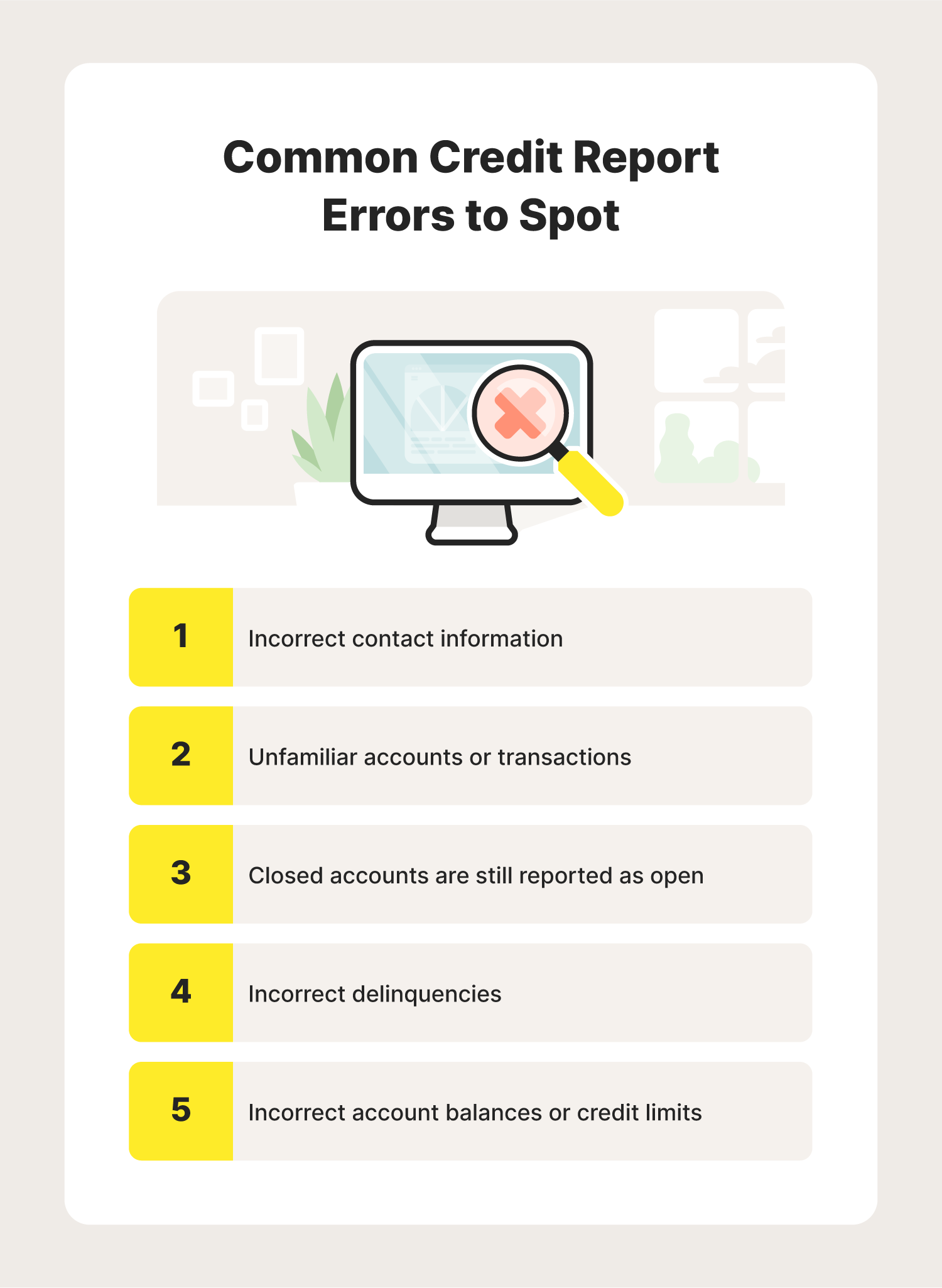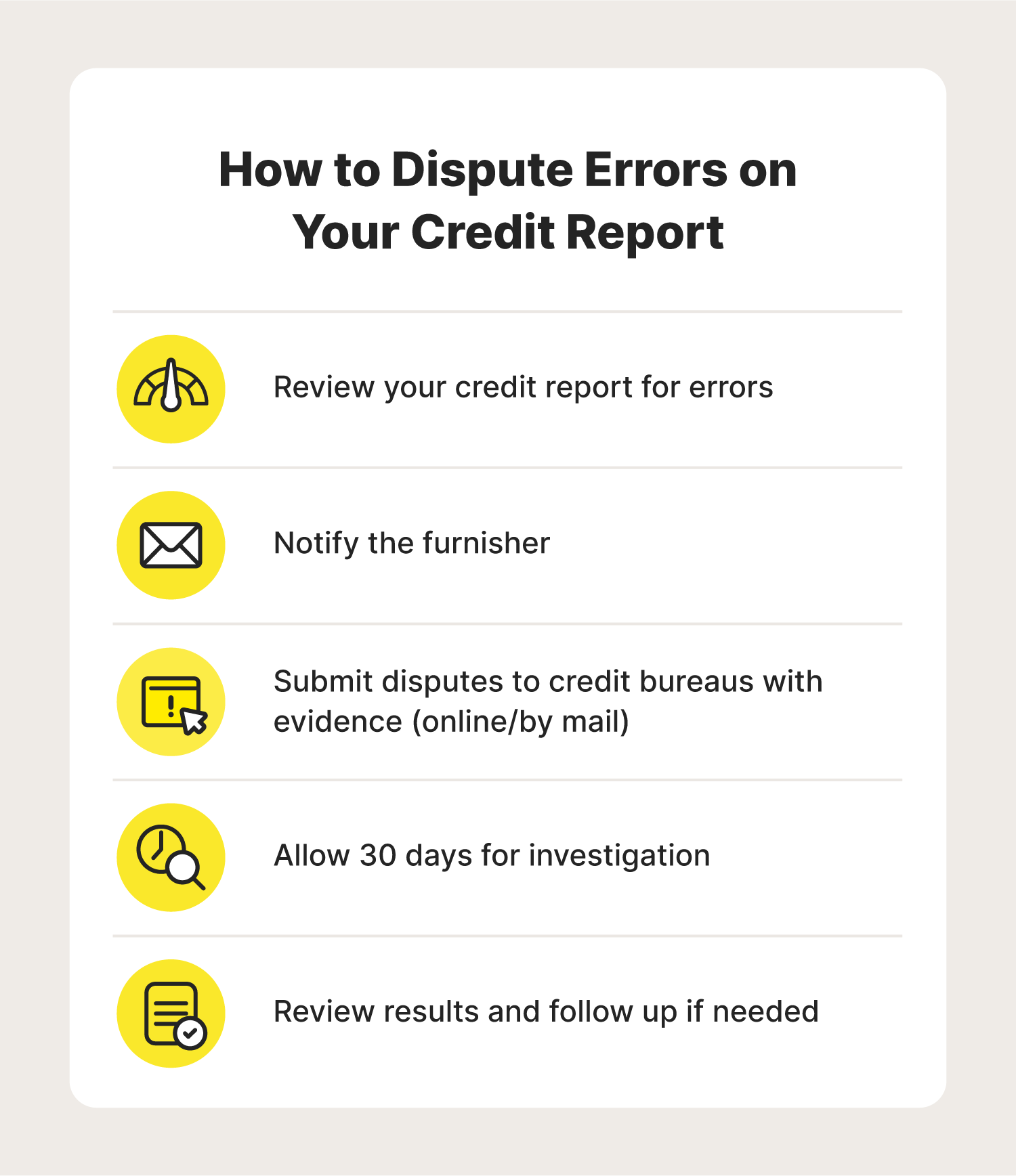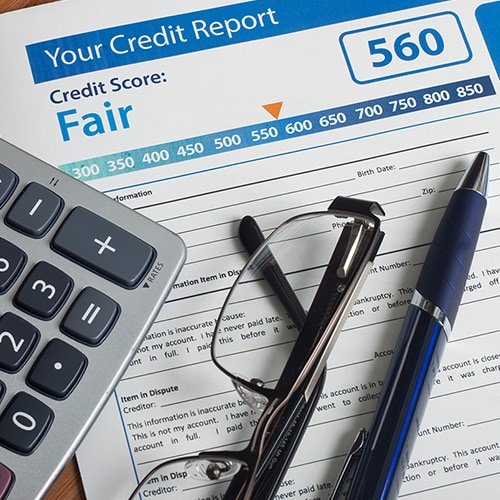Credit report errors can impact your credit score and are more common than you might think—which makes knowing how to dispute something on your credit report a big deal. Credit scores function as a summation of your credit-related behavior to date. This information impacts your ability to borrow cash, obtain credit cards, get insurance, or close on that dream home.
Suppose you find something in your credit report that doesn’t belong there. You’ll need to contact both the credit bureau that reported the information on your credit report and the company that gave that information to the credit bureau (also known as the furnisher).
Here’s how to dispute a charge on your credit report.
1. Review your credit report for errors
Review your credit reports periodically for inaccurate or incomplete information. You can get one free credit report from each of the three major credit bureaus—Equifax®, Experian®, and TransUnion®—once a year at the Annual Credit Report website. You can also subscribe to a credit monitoring service and review your report monthly.
Some common credit report errors to look for include:
- Incorrect personal information: This includes identity mistakes like an incorrect name, phone number, or address.
- Unfamiliar accounts or transactions: This is a “mixed file” containing account information belonging to another consumer. This may occur when you and another consumer have the same or similar names.
- Incorrect account information: This could be a closed account that’s still being reported as open or incorrect reporting of you as an account owner when you are just an authorized user on an account.
- Incorrect delinquencies: This could be a remedied delinquency, such as a collections account, that you paid off yet still shows as unpaid.
- Other account mistakes: This includes accounts listed more than once with different creditors, incorrect account balances, incorrect credit limits, or inaccurate bankruptcies.
Spotted an error? The next step explains how to dispute a credit report error once you identify it.


2. Notify the furnisher
To ensure your request gets resolved, you can also contact the furnisher or the company that supplied the disputed information. Furnishers include your bank, credit card company, utility company, or landlord. Use the Federal Trade Commission's sample letter to tell the furnisher the error you’re disputing, and include all of the same information you sent to the credit bureau:
- Your full name, address, and phone number
- Credit report confirmation number
- Copies (not originals) of any documents or records that support your position
- A clear request for the error you want fixed or removed
- The card account number associated with the error in question
- A copy of your credit report with the errors highlighted
3. Submit your dispute to the credit bureau
You’ll also need to contact the credit bureau to alert them of the error and why you believe it’s a mistake. You generally have three options for contacting the credit bureaus: online, by mail, or by phone. The Federal Trade Commission (FTC) recommends sending your dispute by mail to ensure you have copies of all communications.
Note: Report identity theft to credit bureaus, too. Identity theft can have a big impact on your credit, so it’s better to be proactive and resolve things before it’s too late.
How to dispute by mail
You can use a sample letter or write your own to share details about inaccuracies on your credit report with credit bureaus. However, a sample letter can be easier to use because it outlines what information to include, from presenting the facts to requesting that the error be removed or corrected.
In addition to your written explanation of the errors you’re disputing, be sure to include the following in your letter:
- Your full name, address, and phone number
- Credit report confirmation number
- Copies (not originals) of any documents or records that support your position
- A clear request for the error you want fixed or removed
- The card account number associated with the error in question
- A copy of your credit report with the errors highlighted
Send your letter by certified mail with a return receipt so you have proof that you sent it.
Below are the mailing addresses of the three major credit bureaus. Select the address of the bureau you need to contact:
- Equifax: Equifax Information Services LLC, P.O. Box 740256, Atlanta, GA 30348
- Experian: Experian, P.O. Box 4500, Allen, TX 75013
- TransUnion: TransUnion LLC Consumer Dispute Center, P.O. Box 2000, PA 19016
How to dispute online or by phone
If you prefer to dispute credit report errors online or over the phone, you can do so using the contact information for the three major credit bureaus below:
Equifax:
- Online: Submit a dispute here
- Phone: Call (888) 397-3742
Experian:
- Online: Submit a dispute here
- Phone: Call (888) 397-3742
TransUnion:
- Online: Submit a dispute here
- Phone: Call (800) 916-8800
4. Allow the credit bureau or furnisher to investigate
Next, give the credit bureau and/or furnisher time to investigate the disputed items. The process usually takes fewer than 30 days. They must send relevant information to the information provider—meaning whoever reported the disputed item. The provider must investigate the dispute and report back to the credit reporting bureau.
If you’re right—and it is an error—the information provider has to notify the three major credit bureaus so they can correct the information in your credit reports.
The credit bureau or the company that provided the information (the furnisher) can also determine that your claim is frivolous, in which case they can decide not to investigate your claim. But they must let you know they’ve declined to investigate your dispute by written notice within five days.
5. Review your completed dispute
Once the investigation is complete, the credit bureau will send you the investigation results in writing. If the bureau does find the information to be inaccurate, they will update your credit report accordingly. They must also notify the other major credit bureaus to ensure consistency across your credit files.
6. Follow up if the dispute is not resolved
If the furnisher continues to report the error, you can ask the credit bureaus to include a statement in your credit file describing your side of the dispute, which will be included in future credit reports. For a fee, you can usually ask the credit bureau to send a copy of the statement to anyone who has recently received a copy of your report.
If you believe you were treated unfairly or a valid error remains on your credit report, you can also file a complaint here with the Consumer Financial Protection Bureau (CFPB). The CFPB is required to forward the complaint to the company you have an issue with. You can usually expect a response from the CFPB within 15 days.


Keep your credit report (and identity) safe
Disputing errors on your credit report can help you fix your credit health and save money on loans and credit. While the process can take time to resolve, it’s worth the effort—both for the safety of your personal information and for maintaining a good credit score.
To help safeguard your credit report information, consider an identity theft protection service like LifeLock Ultimate Plus, which provides you with a daily credit score and report from one bureau. LifeLock also monitors your accounts for suspicious activity and helps you with legal, technical, and financial support in the event of fraud.
Editor’s note: Our articles provide educational information. LifeLock offerings may not cover or protect against every type of crime, fraud, or threat we write about.
This article contains
Start your protection,
enroll in minutes.
LifeLock is part of Gen – a global company with a family of trusted brands.
Copyright © 2025 Gen Digital Inc. All rights reserved. Gen trademarks or registered trademarks are property of Gen Digital Inc. or its affiliates. Firefox is a trademark of Mozilla Foundation. Android, Google Chrome, Google Play and the Google Play logo are trademarks of Google, LLC. Mac, iPhone, iPad, Apple and the Apple logo are trademarks of Apple Inc., registered in the U.S. and other countries. App Store is a service mark of Apple Inc. Alexa and all related logos are trademarks of Amazon.com, Inc. or its affiliates. Microsoft and the Window logo are trademarks of Microsoft Corporation in the U.S. and other countries. The Android robot is reproduced or modified from work created and shared by Google and used according to terms described in the Creative Commons 3.0 Attribution License. Other names may be trademarks of their respective owners.




